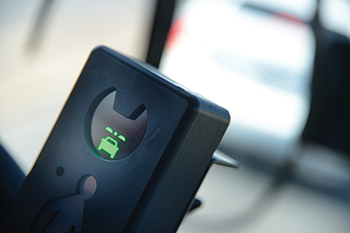The Lone Star State has experienced an increase in the number of pedestrians and bicyclists who have lost their lives in roadway crashes. Within the last decade, pedestrian and bicyclist fatalities rose by 69 percent in Texas. These statistics — but, even more so, the real people behind the numbers — present a safety concern for reducing crashes, especially in urban areas.

The Texas A&M Transportation Institute (TTI) conducted the innovative research project Automated and Connected Vehicle (AV/CV) Test Bed to Improve Transit, Bicycle and Pedestrian Safety. Texas Department of Transportation (TxDOT) Project 0-6875-03 was a multi-year, three-phase cooperative effort by TTI, with Texas A&M University, the City of College Station, and the Brazos Transit District providing support.
The project focused on ways to improve safety involving buses, bicyclists and pedestrians using AV/CV technologies. Providing alerts to pedestrians and bicyclists that buses are turning at signalized intersections is one approach tested in the project.
TTI Executive Associate Director Katie Turnbull notes, “The first phase of the project looked at defining the issues, and we held 25 meetings throughout the state, a variety of workshops, and roundtable forums to really help define the issue, the problems, and where conflicts among buses, bicyclists and pedestrians are occurring.”
Phase I also allowed for research on AV/CV technologies to help address the issues. In Phase II, researchers developed and piloted a smart intersection at the Texas A&M-RELLIS campus. The team performed a proof of concept with the Brazos Transit District’s buses to evaluate visual and audio alerts to pedestrians and bicyclists that a bus was turning.

During Phase I, the Rosco MobileEye® Shield+™ collision-warning system was piloted on one Texas A&M bus. The system uses cameras and sensors to detect if a pedestrian or bicyclist is too close to the bus and a collision might occur. The bus operator is alerted by yellow and red lights and a buzzer to take appropriate action. During Phase III, upgraded MobileEye systems were installed on new Texas A&M buses to continue the pilot.
Phase III included installation of the technology at Penberthy Boulevard and George Bush Drive, an intersection close to busy campus activity. Texas A&M Transportation Services and the City of College Station collaborated with TTI during this phase. Ten Texas A&M buses were equipped with dedicated short-range communications radios, and the City of College Station allowed the use of the traffic signal system.
Supporting projects using AV/CV technologies could make intersections and urban areas safer for buses, pedestrians, bicyclists and other road users across Texas.
“Anytime we can reduce the risk of a crash — especially between a large vehicle and a vulnerable roadway user — it’s a success,” says Bonnie Sherman, bicycle and pedestrian program supervisor in TxDOT’s Public Transportation Division. “We have an opportunity to use technology to avoid some almost certainly fatal crashes, so it’s our responsibility to advance and share that technology.”



